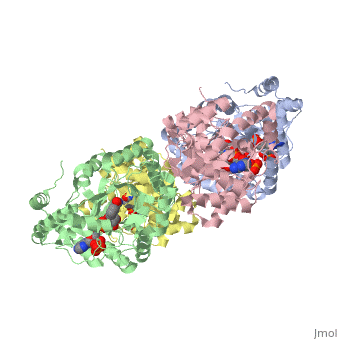Ion channels: Difference between revisions
Michal Harel (talk | contribs) No edit summary |
Michal Harel (talk | contribs) No edit summary |
||
| Line 48: | Line 48: | ||
== Disease == | == Disease == | ||
Mutations in sodium channel are involved in arrhythmia<ref>PMID:19377496</ref>, epilepsy<ref>PMID:16075041</ref>, Brugada syndrome and cardiac conduction disease<ref>PMID:18464934</ref>. Many diseases are related to voltage-gated sodium, potassium, chloride, acetylcholine and glycine ion channels<ref>PMID:11310970</ref>. Mutations in several members of the calcium-activated chloride channels or anoctamin are liked to several diseases: ano-1 to cancer, ano-5 to muscular dystrophy, ano-10 to ataxia and ano-6 to Scott syndrome<ref>PMID:21642943</ref><br /> Mutations in bestrophin are associated with macular dystrophy<ref>PMID:24328569</ref>.<br />[[Amiodarone]] | Mutations in sodium channel are involved in arrhythmia<ref>PMID:19377496</ref>, epilepsy<ref>PMID:16075041</ref>, Brugada syndrome and cardiac conduction disease<ref>PMID:18464934</ref>. Many diseases are related to voltage-gated sodium, potassium, chloride, acetylcholine and glycine ion channels<ref>PMID:11310970</ref>. Mutations in several members of the calcium-activated chloride channels or anoctamin are liked to several diseases: ano-1 to cancer, ano-5 to muscular dystrophy, ano-10 to ataxia and ano-6 to Scott syndrome<ref>PMID:21642943</ref><br /> Mutations in bestrophin are associated with macular dystrophy<ref>PMID:24328569</ref>.<br />[[Amiodarone]] and [[Amlodipine]] are voltage-gated calcium channel blockers used in treatment of cardiac dysrhythmias. | ||
==Additional Resources== | ==Additional Resources== | ||
Revision as of 12:29, 15 January 2024
FunctionIon channels are membrane proteins that catalyze the passive transport of ions through the cell membrane. Ion channels are the fastest of all membrane transporters, with 106 to 108 transported units per second versus 102 to 104 molecules per second for porters/carriers, or 100 to 103 for ATP-driven pumps. Ion channel typesMost ion channels are specific to an ion, like the sodium channels, or the Potassium Channel[1]. TRP channels let through various cations[2]. Cyclic Nucleotide-Gated channels (CNGC) conduct cations upon binding of cAMP or cGMP[11]. Acid-Sensitive channels (ASC) conduct cations upon binding of acid[12].
ClassificationTCDB, the most sophisticated classification of transport proteins to date, classify ion channels as a heterogenous subset of all α-type channels, whose singular property is to consist mainly of α-helices that span the membrane. They are distinct in this from the beta-barrel porins and the pore-forming toxins, as well as from non-ribosomally synthesized channels like gramicidin, polyglutamine or digitoxin. All these proteins are passive transport proteins. DiseaseMutations in sodium channel are involved in arrhythmia[15], epilepsy[16], Brugada syndrome and cardiac conduction disease[17]. Many diseases are related to voltage-gated sodium, potassium, chloride, acetylcholine and glycine ion channels[18]. Mutations in several members of the calcium-activated chloride channels or anoctamin are liked to several diseases: ano-1 to cancer, ano-5 to muscular dystrophy, ano-10 to ataxia and ano-6 to Scott syndrome[19] Additional ResourcesFor additional information, see: Membrane Channels & Pumps For additional information, see: Hypertension & Congestive Heart Failure
3D structures of ion channels
|
| ||||||||||
WeblinksWeblinks
ReferencesReferences
- ↑ Szewczyk A, Jarmuszkiewicz W, Kunz WS. Mitochondrial potassium channels. IUBMB Life. 2009 Feb;61(2):134-43. doi: 10.1002/iub.155. PMID:19165895 doi:http://dx.doi.org/10.1002/iub.155
- ↑ Venkatachalam K, Montell C. TRP channels. Annu Rev Biochem. 2007;76:387-417. PMID:17579562 doi:http://dx.doi.org/10.1146/annurev.biochem.75.103004.142819
- ↑ Zadek B, Nimigean CM. Calcium-dependent gating of MthK, a prokaryotic potassium channel. J Gen Physiol. 2006 Jun;127(6):673-85. PMID:16735753 doi:http://dx.doi.org/10.1085/jgp.200609534
- ↑ Kloda A, Martinac B. Mechanosensitive channels of bacteria and archaea share a common ancestral origin. Eur Biophys J. 2002 Mar;31(1):14-25. PMID:12046893
- ↑ Lacinova L. Voltage-dependent calcium channels. Gen Physiol Biophys. 2005 Jun;24 Suppl 1:1-78. PMID:16096350
- ↑ Shoshan-Barmatz V, Israelson A, Brdiczka D, Sheu SS. The voltage-dependent anion channel (VDAC): function in intracellular signalling, cell life and cell death. Curr Pharm Des. 2006;12(18):2249-70. PMID:16787253
- ↑ Kunzelmann K, Tian Y, Martins JR, Faria D, Kongsuphol P, Ousingsawat J, Thevenod F, Roussa E, Rock J, Schreiber R. Anoctamins. Pflugers Arch. 2011 Aug;462(2):195-208. doi: 10.1007/s00424-011-0975-9. Epub 2011, May 21. PMID:21607626 doi:http://dx.doi.org/10.1007/s00424-011-0975-9
- ↑ Strauss O, Neussert R, Muller C, Milenkovic VM. A potential cytosolic function of bestrophin-1. Adv Exp Med Biol. 2012;723:603-10. doi: 10.1007/978-1-4614-0631-0_77. PMID:22183384 doi:http://dx.doi.org/10.1007/978-1-4614-0631-0_77
- ↑ Keramidas A, Moorhouse AJ, Schofield PR, Barry PH. Ligand-gated ion channels: mechanisms underlying ion selectivity. Prog Biophys Mol Biol. 2004 Oct;86(2):161-204. PMID:15288758 doi:http://dx.doi.org/10.1016/j.pbiomolbio.2003.09.002
- ↑ Structural evidence for the binding of monocarboxylates and dicarboxylates at pharmacologically relevant extracellular sites of a pentameric ligand-gated ion channel. Acta Cryst. (2020). D76, 668-675 doi:https://dx.doi.org/10.1107/S205979832000772X
- ↑ Kaupp UB, Seifert R. Cyclic nucleotide-gated ion channels. Physiol Rev. 2002 Jul;82(3):769-824. PMID:12087135 doi:http://dx.doi.org/10.1152/physrev.00008.2002
- ↑ Holzer P. Acid-sensitive ion channels and receptors. Handb Exp Pharmacol. 2009;(194):283-332. doi: 10.1007/978-3-540-79090-7_9. PMID:19655111 doi:http://dx.doi.org/10.1007/978-3-540-79090-7_9
- ↑ Keramidas A, Moorhouse AJ, Schofield PR, Barry PH. Ligand-gated ion channels: mechanisms underlying ion selectivity. Prog Biophys Mol Biol. 2004 Oct;86(2):161-204. PMID:15288758 doi:http://dx.doi.org/10.1016/j.pbiomolbio.2003.09.002
- ↑ Stroud RM, Miercke LJ, O'Connell J, Khademi S, Lee JK, Remis J, Harries W, Robles Y, Akhavan D. Glycerol facilitator GlpF and the associated aquaporin family of channels. Curr Opin Struct Biol. 2003 Aug;13(4):424-31. PMID:12948772
- ↑ Ruan Y, Liu N, Priori SG. Sodium channel mutations and arrhythmias. Nat Rev Cardiol. 2009 May;6(5):337-48. doi: 10.1038/nrcardio.2009.44. PMID:19377496 doi:http://dx.doi.org/10.1038/nrcardio.2009.44
- ↑ Meisler MH, Kearney JA. Sodium channel mutations in epilepsy and other neurological disorders. J Clin Invest. 2005 Aug;115(8):2010-7. PMID:16075041 doi:http://dx.doi.org/10.1172/JCI25466
- ↑ Watanabe H, Koopmann TT, Le Scouarnec S, Yang T, Ingram CR, Schott JJ, Demolombe S, Probst V, Anselme F, Escande D, Wiesfeld AC, Pfeufer A, Kaab S, Wichmann HE, Hasdemir C, Aizawa Y, Wilde AA, Roden DM, Bezzina CR. Sodium channel beta1 subunit mutations associated with Brugada syndrome and cardiac conduction disease in humans. J Clin Invest. 2008 Jun;118(6):2260-8. doi: 10.1172/JCI33891. PMID:18464934 doi:http://dx.doi.org/10.1172/JCI33891
- ↑ Dworakowska B, Dolowy K. Ion channels-related diseases. Acta Biochim Pol. 2000;47(3):685-703. PMID:11310970
- ↑ Duran C, Hartzell HC. Physiological roles and diseases of Tmem16/Anoctamin proteins: are they all chloride channels? Acta Pharmacol Sin. 2011 Jun;32(6):685-92. doi: 10.1038/aps.2011.48. PMID:21642943 doi:http://dx.doi.org/10.1038/aps.2011.48
- ↑ Pasquay C, Wang LF, Lorenz B, Preising MN. Bestrophin 1--Phenotypes and Functional Aspects in Bestrophinopathies. Ophthalmic Genet. 2015;36(3):193-212. doi: 10.3109/13816810.2013.863945. PMID:24328569 doi:http://dx.doi.org/10.3109/13816810.2013.863945
